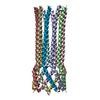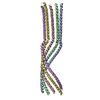+Search query
-Structure paper
| Title | Icosahedral bacteriophage ΦX174 forms a tail for DNA transport during infection. |
|---|---|
| Journal, issue, pages | Nature, Vol. 505, Issue 7483, Page 432-435, Year 2014 |
| Publish date | Jan 16, 2014 |
 Authors Authors | Lei Sun / Lindsey N Young / Xinzheng Zhang / Sergei P Boudko / Andrei Fokine / Erica Zbornik / Aaron P Roznowski / Ian J Molineux / Michael G Rossmann / Bentley A Fane /  |
| PubMed Abstract | Prokaryotic viruses have evolved various mechanisms to transport their genomes across bacterial cell walls. Many bacteriophages use a tail to perform this function, whereas tail-less phages rely on ...Prokaryotic viruses have evolved various mechanisms to transport their genomes across bacterial cell walls. Many bacteriophages use a tail to perform this function, whereas tail-less phages rely on host organelles. However, the tail-less, icosahedral, single-stranded DNA ΦX174-like coliphages do not fall into these well-defined infection processes. For these phages, DNA delivery requires a DNA pilot protein. Here we show that the ΦX174 pilot protein H oligomerizes to form a tube whose function is most probably to deliver the DNA genome across the host's periplasmic space to the cytoplasm. The 2.4 Å resolution crystal structure of the in vitro assembled H protein's central domain consists of a 170 Å-long α-helical barrel. The tube is constructed of ten α-helices with their amino termini arrayed in a right-handed super-helical coiled-coil and their carboxy termini arrayed in a left-handed super-helical coiled-coil. Genetic and biochemical studies demonstrate that the tube is essential for infectivity but does not affect in vivo virus assembly. Cryo-electron tomograms show that tubes span the periplasmic space and are present while the genome is being delivered into the host cell's cytoplasm. Both ends of the H protein contain transmembrane domains, which anchor the assembled tubes into the inner and outer cell membranes. The central channel of the H-protein tube is lined with amide and guanidinium side chains. This may be a general property of viral DNA conduits and is likely to be critical for efficient genome translocation into the host. |
 External links External links |  Nature / Nature /  PubMed:24336205 PubMed:24336205 |
| Methods | X-ray diffraction |
| Resolution | 2.101 - 2.4 Å |
| Structure data |  PDB-4jpn:  PDB-4jpp: |
| Chemicals |  ChemComp-HOH: |
| Source |
|
 Keywords Keywords | VIRAL PROTEIN / helical barrel / tail tube / pilot DNA during phage infection |
 Movie
Movie Controller
Controller Structure viewers
Structure viewers About Yorodumi Papers
About Yorodumi Papers



 enterobacteria phage phix174 (virus)
enterobacteria phage phix174 (virus)